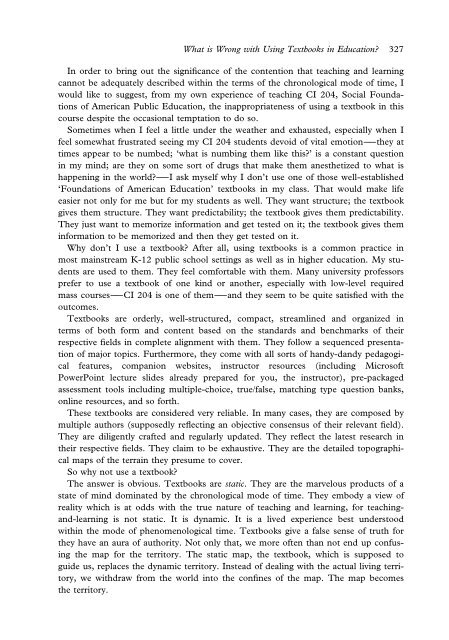Oral 2013 TextBooks
You also want an ePaper? Increase the reach of your titles
YUMPU automatically turns print PDFs into web optimized ePapers that Google loves.
What is Wrong with Using Textbooks in Education? 327<br />
In order to bring out the significance of the contention that teaching and learning<br />
cannot be adequately described within the terms of the chronological mode of time, I<br />
would like to suggest, from my own experience of teaching CI 204, Social Foundations<br />
of American Public Education, the inappropriateness of using a textbook in this<br />
course despite the occasional temptation to do so.<br />
Sometimes when I feel a little under the weather and exhausted, especially when I<br />
feel somewhat frustrated seeing my CI 204 students devoid of vital emotion——they at<br />
times appear to be numbed; ‘what is numbing them like this?’ is a constant question<br />
in my mind; are they on some sort of drugs that make them anesthetized to what is<br />
happening in the world?——I ask myself why I don’t use one of those well-established<br />
‘Foundations of American Education’ textbooks in my class. That would make life<br />
easier not only for me but for my students as well. They want structure; the textbook<br />
gives them structure. They want predictability; the textbook gives them predictability.<br />
They just want to memorize information and get tested on it; the textbook gives them<br />
information to be memorized and then they get tested on it.<br />
Why don’t I use a textbook? After all, using textbooks is a common practice in<br />
most mainstream K-12 public school settings as well as in higher education. My students<br />
are used to them. They feel comfortable with them. Many university professors<br />
prefer to use a textbook of one kind or another, especially with low-level required<br />
mass courses——CI 204 is one of them——and they seem to be quite satisfied with the<br />
outcomes.<br />
Textbooks are orderly, well-structured, compact, streamlined and organized in<br />
terms of both form and content based on the standards and benchmarks of their<br />
respective fields in complete alignment with them. They follow a sequenced presentation<br />
of major topics. Furthermore, they come with all sorts of handy-dandy pedagogical<br />
features, companion websites, instructor resources (including Microsoft<br />
PowerPoint lecture slides already prepared for you, the instructor), pre-packaged<br />
assessment tools including multiple-choice, true/false, matching type question banks,<br />
online resources, and so forth.<br />
These textbooks are considered very reliable. In many cases, they are composed by<br />
multiple authors (supposedly reflecting an objective consensus of their relevant field).<br />
They are diligently crafted and regularly updated. They reflect the latest research in<br />
their respective fields. They claim to be exhaustive. They are the detailed topographical<br />
maps of the terrain they presume to cover.<br />
So why not use a textbook?<br />
The answer is obvious. Textbooks are static. They are the marvelous products of a<br />
state of mind dominated by the chronological mode of time. They embody a view of<br />
reality which is at odds with the true nature of teaching and learning, for teachingand-learning<br />
is not static. It is dynamic. It is a lived experience best understood<br />
within the mode of phenomenological time. Textbooks give a false sense of truth for<br />
they have an aura of authority. Not only that, we more often than not end up confusing<br />
the map for the territory. The static map, the textbook, which is supposed to<br />
guide us, replaces the dynamic territory. Instead of dealing with the actual living territory,<br />
we withdraw from the world into the confines of the map. The map becomes<br />
the territory.


